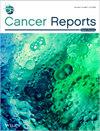Hormone Receptor-Dependent Correlations Between Angiopoietins and VEGF-C in Primary Breast Cancer: Insights Into Lymphangiogenic Biomarkers
Abstract
Background
Biomarkers of angiogenesis and lymphangiogenesis have been explored in cancer prognostic models; however, their potential role in assessing local tumor invasiveness remains poorly understood.
Aims
This study aimed to evaluate the correlations of angiogenic biomarkers, specifically the angiopoietin (ANG)-Tie system and vascular endothelial growth factor-C (VEGF-C), with lymphangiogenesis and the related histopathological characteristics in Iranian women with breast cancer.
Methods and Results
In this consecutive case series (n = 149) from the Breast Cancer Risk and Lifestyle (BCRL) study, plasma levels of pro-angiogenic factors, including VEGF-C, ANGs, and Tie-2, were assessed using ELISA. Clinicopathological data were collected, excluding stage IV cases to focus on patients with localized disease. Axillary lymph node metastasis (ANLM), and vascular invasion (VI) were common in the study population, occurring in 61.5% and 77.6% of cases, respectively (p < 0.01). Estrogen receptor-positive (ER+) tumors were observed in 89.1% of ANLM+ participants, while human epidermal growth factor receptor-2-positive (HER-2+) tumors were identified in 22.8% of patients with ALNM. Plasma levels of ANG-1 (r = 0.19) and VEGF-C (r = 0.29) were positively correlated with the ALNM ratio (p < 0.05). Multivariate analysis in patients with grade II tumors revealed significant inverse correlations between VEGF-C and angiogenic biomarkers, including ANG-2 (β = −0.25), the ANG-2/Tie-2 ratio (β = −0.28), and the (ANG-1 + ANG-2)/Tie-2 ratio (β = −0.29) (p < 0.05). Receiver operating characteristic (ROC) curve analysis indicated that ANG-2 could effectively assess ALNM status, with an optimal cutoff of 3.39 pg/mL, identifying ALNM in 66.0% of patients with low VEGF-C levels (95% CI: 0.54–0.78), increasing to 68.0% when combined with ANG-1 as the ANGs/Tie-2 ratio (95% CI: 0.56–0.80). In ER+ tumors, high plasma ANG-2 levels were observed (p < 0.05). Significantly higher levels of the (ANG-1 + ANG-2)/VEGF-C ratio were noted in patients with VI+ (p < 0.05). Findings descriptively highlighted ER+ status as a common characteristic in VI+ and ALNM+ tumors. In HER-2+ patients, both ANG-1 and the (ANG-1 + ANG-2)/Tie-2 ratio showed inverse correlations with VEGF-C, while in ER− breast cancer patients, ANG-2 was inversely correlated with VEGF-C.
Conclusion
These findings provide new insights into the inverse correlation between plasma levels of ANGs and VEGF-C, particularly in cases with positive ALNM, underscoring the role of hormone receptor-dependent characteristics. The integration of the triple angiogenic biomarkers ANG-2/Tie-2/VEGF-C within the tumor microenvironment, combined with the regulatory influence of hormonal receptors, merits further investigation as a potential biomarker panel for identifying lymphatic anomalies and VI positivity in breast cancer patients.


 求助内容:
求助内容: 应助结果提醒方式:
应助结果提醒方式:


